
We just returned from the Antarctic voyage I described in the Leaf-Peeping Cruise story. At the time we didn't realize we'd be actually making that trip a year later. Since we'd never been to Chile, we went three days early to Santiago and also stayed four days afterwards in Buenos Aires, Argentina.
I may be sending more stories after I sift through the 2,500 or so photos, but in the meantime, here is a taste, taken in Antarctica and South Georgia Island. They include all the Antarctic penguins except the emperor of "March of the Penguins" fame which were far inland. They are somewhat larger but look similar to the king penguins. Maybe if the Russians had found another breed there would also be tsar penguins!
In the meantime, you can follow the progress of our cruise in a blog written by expedition staff members – Day 1 is December 20. For some reason, the link takes you to the trip's end – click on the upper left-most camera symbol to start with Day 1. If you zoom in, you can see exactly where we were each day.
This view includes where we celebrated New Years Eve and New Year's Day.
(This is just a screen shot, so zooming won't work here.)

It also includes the site of our first landing on the Antarctic continent, on December 30, as attested to by this certificate.

This is our ship, the Seabourn Quest, at rest in Cuverville Island bay during a "brochure day," with sunny skies and calm seas that occur only four or five times a season – a day when pictures are taken for the brochures.
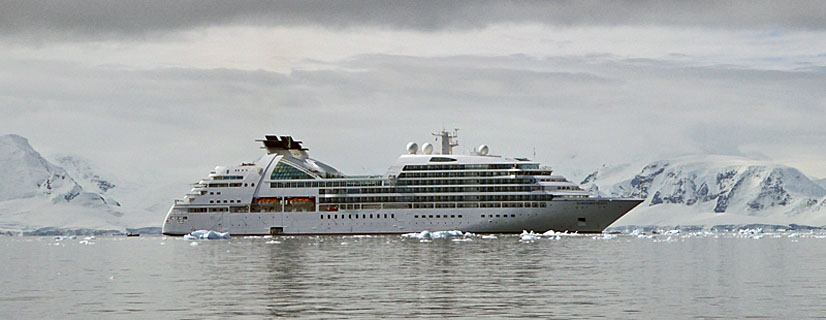
By the way, Antarctica is so dry – it's technically a desert – that when we went from the warmth of the ship to the cold outside air, lenses in glasses, binoculars, and cameras didn't fog up!
A chin strap penguin on Half Moon Island – you may see where the name comes from. The less than pristine coat indicates that this one has just finished a three-day turn on the eggs.
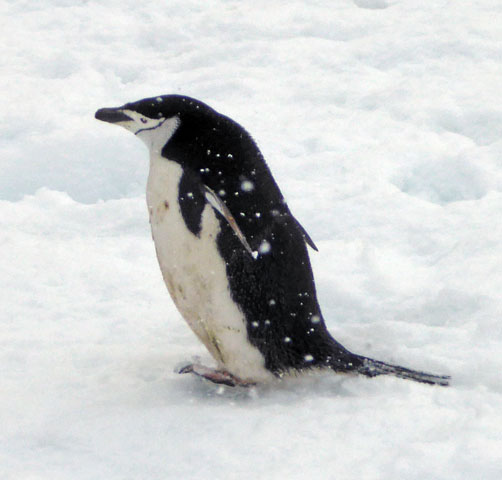
The white speckles are from a light snow falling when our group was ashore. There were five groups – only 100 people are allowed on land at a time, and only from ships with fewer than 500 passengers. The groups alternated departure times, from 8AM to 2PM. The entire process from the first zodiac in the group leaving to the last one returning was 1-1/2 hours, with an on-ground experience of at least an hour for everyone.
We occasionally spotted larger ships on our voyage, but they could only look but not touch. I did wonder why anyone would spend the considerable sum to come all this distance, through potentially treacherous waters – twice – to only view all the fascinating wildlife from a distance.
Get a move on, slowpoke!

A plump, clean, gentoo penguin at Waterboat Point, who has no doubt just returned from his three days off the egg(s) – they generally lay two – or chick(s) – they don't all necessarily survive – to load up on krill, small fish, and squid to sustain him for his three days on. You can see how they differ from the chin strap penguins, with the orange beak and white stripe on the head.
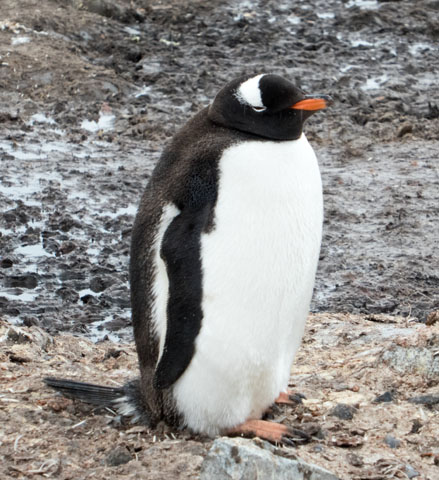
This one, in a hurry, is slimmer. Perhaps he or she is on three day's off rushing off to dine in the sea until it's his turn again.
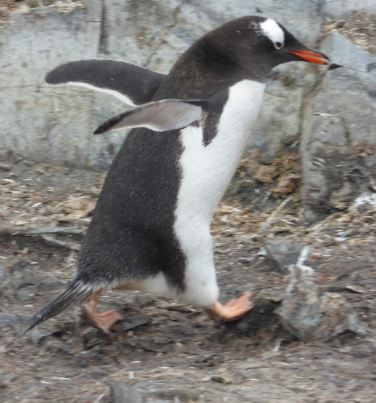
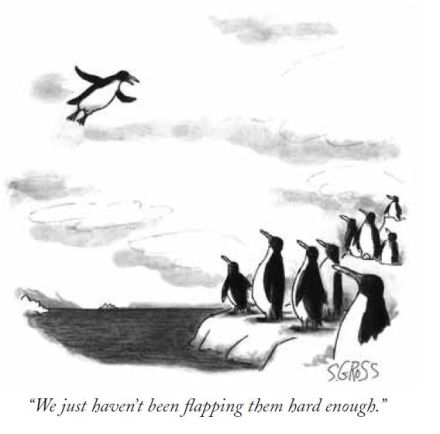
However, that would only be a penguin's dream. Perhaps he or she is just eager to dine in the sea for three days before the next turn on the egg.
A rare gentoo with a pigmentation aberration called leucism, a genetic defect preventing or diluting the deposition of melanin in the feathers, affecting one in 20,000 gentoos. Otherwise they're completely normal and are treated that way by the others.

At least she doesn't have this decision to make every morning.
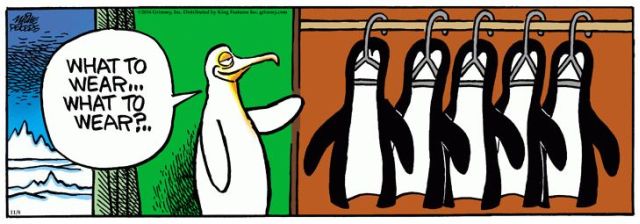
A few Adélie penguins at Esperanza Station welcomed us.
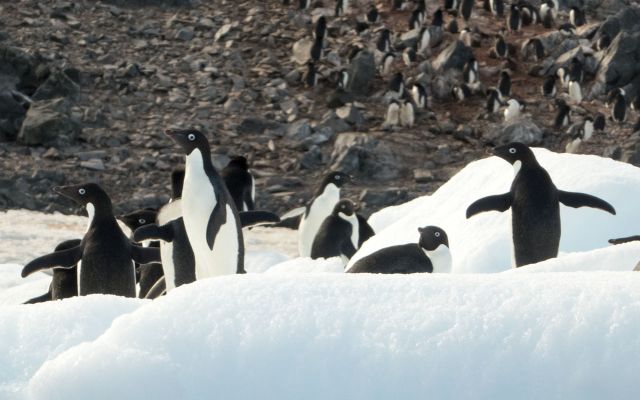
The rest of the gang joined in.
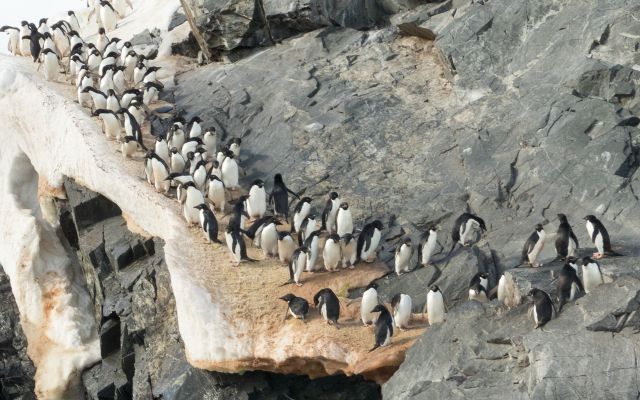
Except for the one that mistook our zodiac for an iceberg!
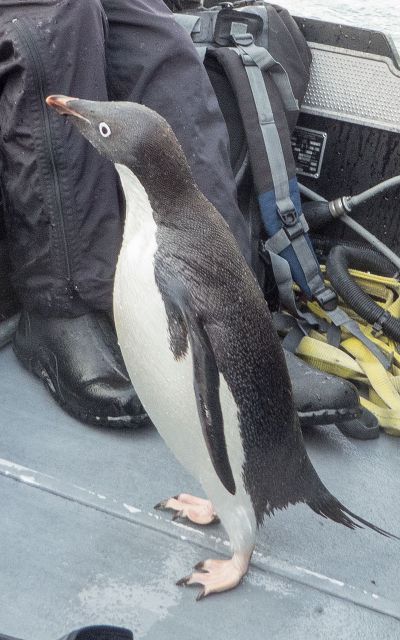
Although they can attain great heights by using momentum after a quick dive, with his short legs this one had difficulty scrambling back out. Finally, using a well-placed boot as a step, he returned to the sea. We were sternly warned not to touch any penguins!
We also spotted this Wedell seal who seemed to be posing, catlike, for us.

Our zodiac tour at Cooper Bay, South Georgia Island gave an idea of the rugged terrain Shackleton's small group had to surmount to reach a whaling station on this side of the island, opposite from where he landed.

A pair of seals shared guide duty,

while a Southern Petrel eyed us suspiciously. There are also Northern Petrels, but you can distinguish them by the color of their bills. It's like a traffic light – Northern ones are red, Southern green. From this view, you might think they're the size of a duck, but they have a six foot wingspan.
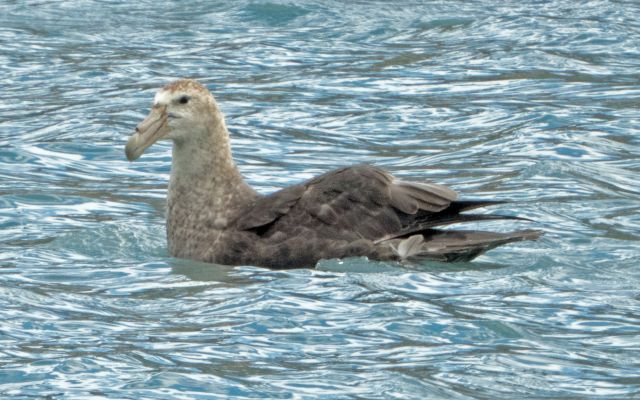
A group of king penguins, some bored with us enough that they're nodding off. Others look a little unkempt because they're molting. Unlike some other birds, whose feathers are gradually replaced one at a time, all the penguins' feathers are replaced at once, during an annual process.
It's quite stressful for them, because during this period, which may take up to a month, they do not have waterproof protection. Not able to swim for food, they undergo a forced fast, a reason it's called a catastrophic molt.

A closer look revealed king penguins hanging around with the seals, one pair of whom seem to be serenading their pup. However, the bystanders weren't impressed.

Still others chilled out in the background.
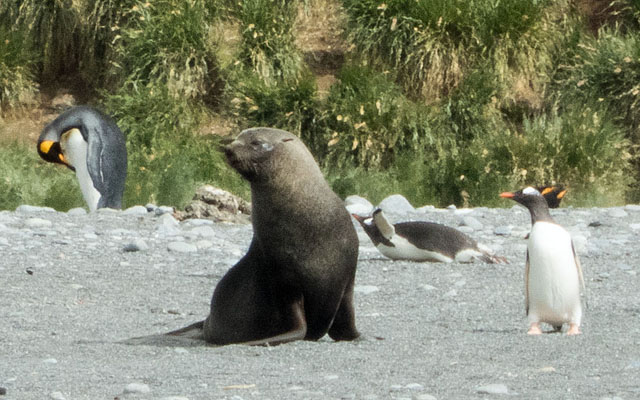
A nearby hill served as a rookery for thousands ...
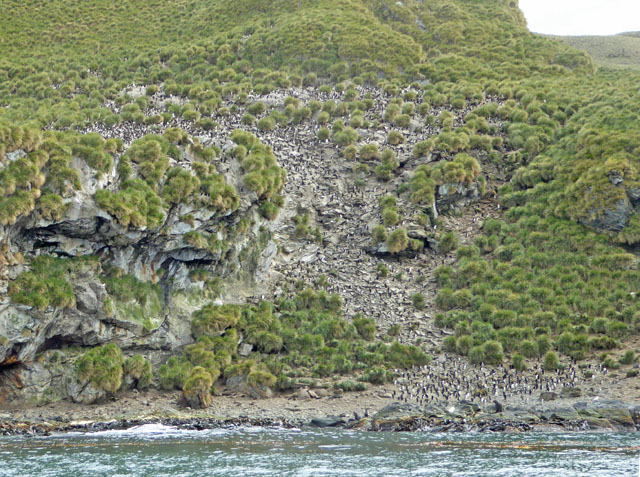
of the clowns: macaroni penguins.
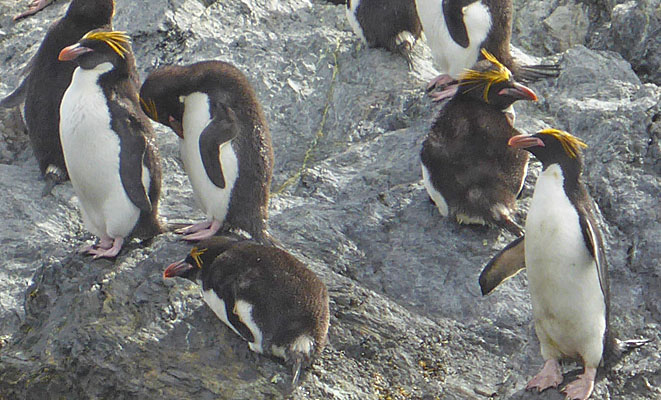
The name was given to them by British explorers during the 18th century because their colorful head feathers resembled those worn in the hats of young men of fashion at the time who were called macaroni. The line in the song Yankee Doodle, "Stuck a feather in his cap and called it macaroni," stems from the same fashion movement.
The next day, January 7th, we came ashore at Grytviken, which includes the rusting remains of a whaling station, a research facility, a church, a museum – with adjacent gift shop,

and a cemetery containing, among others, Shackleton's grave.

Whether by coincidence or not, we arrived on a ship with the same name as the one on which he died offshore almost exactly 94 years previously – ours was the only one of four Quest Antarctic cruises that stopped here.
We picked our way among slumbering seals
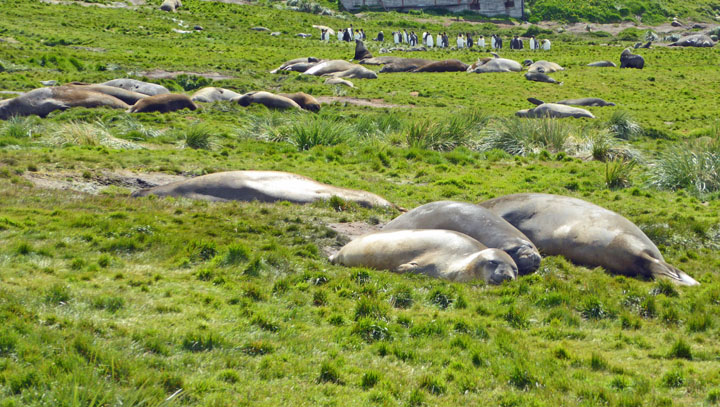
some of whom were annoyed to be disturbed.
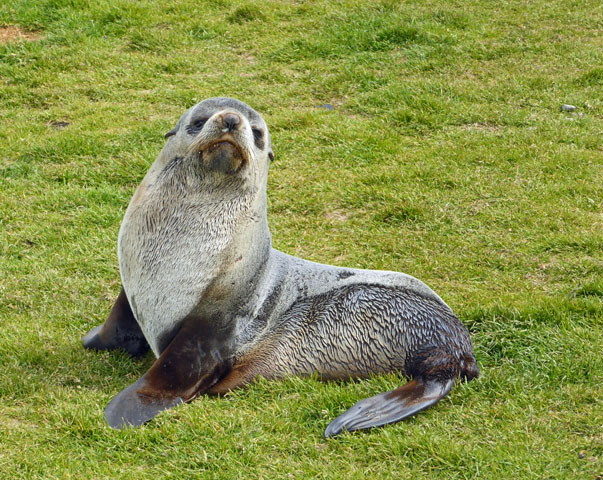
As we sailed away, you can see how happy Georgia is to be away from South Georgia Island before winter arrives.

Peep was glad to have another girl join their group – during the holidays Flo's cousin Cedric and nephew Jerome come to visit.
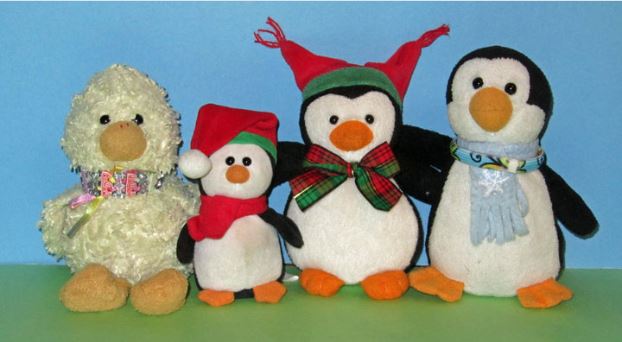
Zodiacs – outboard-motor powered pontoon boats with a metal deck – were the transport mode. When the sea was a little rough, it could be tricky getting into them from the ship and back aboard at the end. The driver ran the nose onto the pebbly beaches where we took turns sliding to the front and pivoting over the side into shallow water.
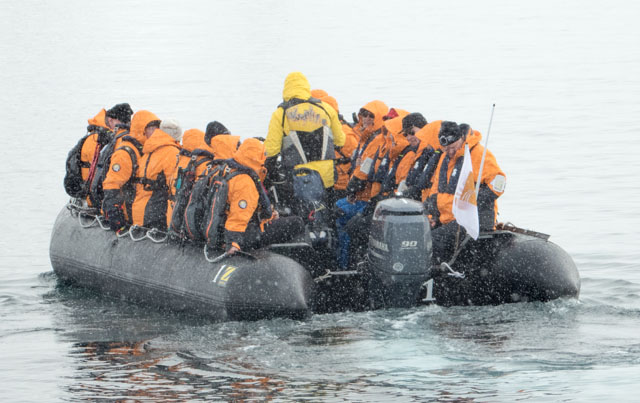
Bundled up in a "base layer" – long underwear, although much lighter than the old type – pants and shirt, a puffy jacket, woolen cap that could be pulled down over the ears, waterproof parka with hood, waterproof pants and gloves, thick merino wool socks, 15" high rubber boots (aka "dairy boots") and life jacket, we were just like the penguins – waddling along, indistinguishable one from the other!
I just realized that wasn't completely true – Betty Lou's polka-dot boots made her as distinguishable as a leucistic penguin!
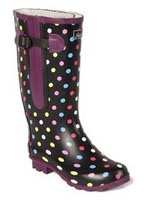
Most of the time we were warm enough that even when unzipping top layers somewhat we were sweaty when we returned to the ship. Summer temperatures in Antarctica are usually in the 30s – warmer than when we returned home! – but we had to be prepared for sudden weather changes, including frigid katabatic winds that could swoop down from elevated ice sheets.
In fact, on the Esperanza Station zodiac tour, when we were the first group, after a while the winds picked up and waves splashed over the bow, and sides, testing the waterproofing of our outer clothing layer. Some found the pants they had purchased were only water repellent. The taste of the water splashing in our face proved it was indeed salt water. We were wearing sun glasses so it didn't irritate our eyes, unlike some that were not similarly equipped. Betty Lou called out, "Aren't we having fun?" Laughing, all agreed
However, the conditions had become dangerous enough – the wind had increased from 17 knots to over 40 – that the expedition leaders called off any further tours that day. Although some who witnessed the approach and unloading of our zodiacs from the decks above – "Were you on that last one! We didn't think you'd make it!" – were glad not to have been there, those who viewed our photos were disappointed not to have been able to have the same experience1.
Well, maybe not the testing of waterproof garments or the evidence of salt water!
1... particularly because, although we had the opportunity to view the other species of penguins at more than one location, this was the only site we visited that had Adélies.